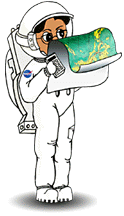Earth: The Water Planet |
Earth: The Water Planet |
![]()
 |
Wow!Earth is the only inner planet in our solar system that has liquid water on its surface. Seventy percent of the surface is covered by oceans where photosynthesis takes place. This makes the ocean the principal life habitat on Earth. |
| Earth's amazing gaseous atmosphere is responsible for making life possible on this, the third planet from the Sun. Our atmosphere contains water vapor which helps to moderate our daily temperatures. Our atmosphere contains 21% oxygen, which is necessary for us to breathe, 78% nitrogen, and .9% argon. The other 0.1% consists of water vapor, carbon dioxide, neon, methane, krypton, helium, xenon, hydrogen, nitrous oxide, carbon monoxide, nitrogen dioxide, sulfur dioxide, and ozone. These latter elements are important to have because they help to absorb harmful solar radiation before it can reach the surface of the Earth. If present in larger amounts, most of these latter elements would be poisonous to humans. The atmosphere protects us from meteors as well. Due to the friction generated between a meteor and the atmospheric gases, most meteors burn up before hitting Earth's surface as a meteorite. |
|
|
Earth rotates on an imaginary axis which is tilted at a 23.5 degree angle. The rotation is what causes the change from day to night. The tilt is what determines our change in seasons. If the Earth was not tilted, we would have the same season all year long. Earth has a core of molten iron-nickel. The rapid spin of the Earth along with the liquid, hot metallic core causes a magnetic field to surround the Earth. This magnetic field traps the charged particles which are hurled at the Earth by the Sun during solar wind activity. When these charged particles react with the gases in our atmosphere, the gases begin to glow. These aurorae, or glowing gases, are seen in the Arctic Circle and the Antarctic Circle. As with all inner planets, Earth's surface has been affected by volcanism, tectonic activity, and to a lesser degree, meteorite impacts. Earth has one naturally occurring satellite, the Moon. |
A QuestionWhat produces the magnetic field which surrounds the Earth? |
| The Facts |
Did you know? |
The Answer |
![]()
| Show me the Level 1 version of this page. |
The StarChild site is a service of the High Energy Astrophysics Science Archive Research Center (HEASARC), within the Astrophysics Science Division (ASD) at NASA/ GSFC.
StarChild Authors: The StarChild Team
StarChild Graphics & Music: Acknowledgments
StarChild Project Leader: Dr. Laura A.
Whitlock
Curator:
Responsible NASA Official: